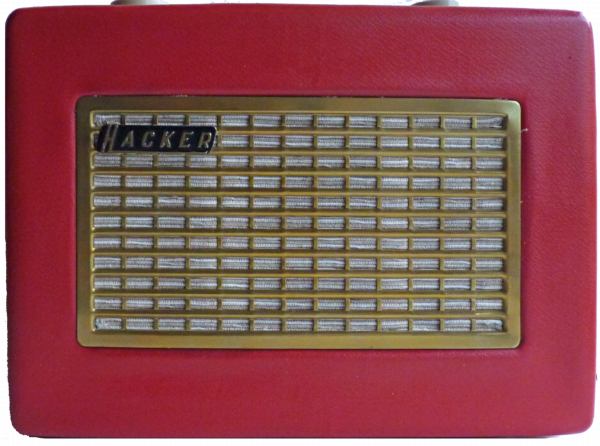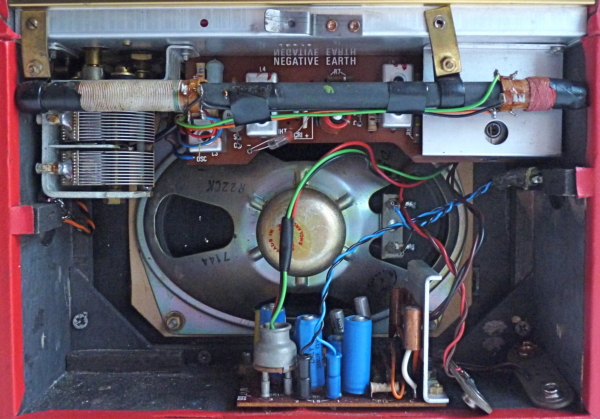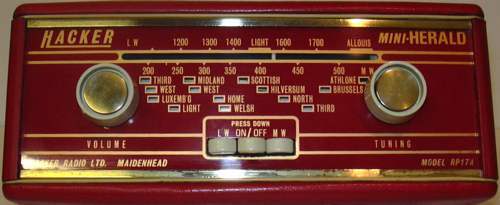
Serial number 72313

Portable Transistor radio Made by Hacker Radio Ltd,
Maidenhead UK. This radio is housed in a red leatherette covered wooden
case.
This is a good quality radio with 7 transistors covering medium and
long wavebands. It has sockets for headphones and external aerial (on
left and right hand sides). This radio is normally powered by two 9
volt PP9 batteries in series. This is one of two Hacker radios that I
purchased for � 10.60 on Ebay back in 2010. working
Maidenhead, UK 1964 approx.

View of interior
Note the substantial loudspeaker and separate audio amplifier and the connectors for two 9 volt batteries.

Top of radio showing dial and controls.
Stewart Kitch has sent me the following information about his career at Airmec which sheds an interesting light upon the manufacture of some Hacker radios.
I moved back to Somerset to work at Airmec at Seaton Devon, firstly as a "test improver". While "improving" I worked on valve test equipment such as their Signal generator 210 and wave analyser 853, prior to a Racal take-over in about 1969. I then calibrated and repaired the test equipment, and saw some examples of this on your web site. At this time we also had a contract to build and test Hacker radios, such as the Herald, and I remember building a stereo record player using 2 of audio amps! We had 2 Test personnel; I tested all the instruments and the other guy did the Hacker Radios. As Racal expanded I ran a section that tested a range of "Racal Instruments" products which were largely frequency counters. Several other Racal companies ran our site, with more profit being made on military radios such as the 931X. I think I could still test one of those in my sleep!
Cellular radio then reared its head and we made the car "transportable" model, before making a few "almost portable" models. These were fairly troublesome, but Racal made a good profit and started Racal-Vodafone as it was then. We later made the most complicated 39D military radio and were waiting for the Bowman project which was eventually awarded to another company. Following rumours of a take-over by Thompson CSF, we were closed in 2000 and all made redundant, the factory being demolished a few weeks ago. Racal became Thales, but Vodafone continues.
I believe Airmec opened their second factory at Seaton in 1965 to make use of our cheaper labour! The "Banbury" was the first building, made of concrete panels and located on the site of the Southern Railway station which was not demolished until later (1969?) High Wycombe remained the Head office and were always keen to tell us where we were going wrong! During a holiday last year, another couple joined us at our table who hailed from Wycombe. I told her of Airmec and she said she worked there after leaving school as a typist, and knew several of the directors and staff including Fred Pears, who was in charge of Seaton. She started in the late 50's and left when her family arrived.
Besides the Hacker contract there was also a Motorola contract for car radio sub assemblies, which ceased soon after I arrived. Another "flop" was "Telefi", a small box which picked up the sound from your TV IF to feed into your Hi-Fi for much better sound. They were constructed in nice wooden boxes - I still have loads of small wood screws that were used!
Thinking hard, I believe we made 2 models of Hacker Radios, but although one looked like the Herald, I'm sure that was not the name. It was a long time ago though.

